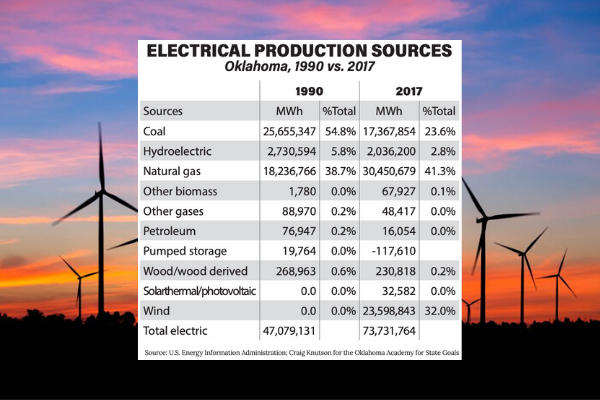OKLAHOMA CITY – Generation of electricity in Oklahoma has grown by 57% in the past 27 years, and the manner in which it is produced has changed dramatically.
Data to support those claims was furnished by Craig Knutson, Town Hall research chairman for the Oklahoma Academy for State Goals. The academy released on Feb. 4 its findings and recommendations that its participants developed in reference to energy production, energy and the environment, and energy-related economic and regulatory issues.
“The most notable changes from the individual sources used to generate ... electricity are the dramatic increase in the contribution wind provided to the total (now 32%); a 67% increase in the use of natural gas; and the 32% decline in coal usage to generate electricity,” Knutson wrote.
Town Hall attendees “ought to consider what the next 27 years might look like in terms of not only the amount of electricity needed” but the sources, too, Knutson wrote. “Is solar likely to mirror the growth of wind from the past 27 years? If so, what needs to occur to encourage this cheaply manufactured technology onto the grid?”
Knutson, who is the president and chief executive officer of the Potts Family Foundation, found that:
• megawatt hours of electricity generated in Oklahoma by burning oil plummeted by 79%, while power generation from wind “farms” soared from zero in 1990 to nearly 23.6 million MWh in 2017;
• electricity generation from solar and photovoltaic sources multiplied from zero in 1990 to almost 32,600megawatt hours in 2017;
• MWh of power produced from hydroelectric sources declined by 700,000 during that 27-year span;
• use of biomass for power generation jumped from 1,780 MWh in 1990 to almost 68,000 MWh in 2017. (Biomass is plant or animal material such as purposely grown energy crops, wood or forest residues, waste from food crops, horticulture, food processing, animal farming, or even human waste from wastewater treatment plants.)
Gov. Stitt’s administration “will promote policies that play to Oklahoma’s strengths and that concentrate our efforts on the responsible development and production of energy in all forms,” wrote Kenneth Wagner, state Secretary of Energy and Environment.
The function of renewables is “to produce electricity for distribution on the grid,” Wagner said. Petroleum and natural gas “continue to offer reliability in the grid while also providing the basis for many household items” ranging from plastic pens to rubber in tires.
Nationwide, Oklahoma ranks #3 in natural-gas production, #4 in production of oil, and #3 in wind energy generation, Wagner added.
In a related matter, Maryland enacted a law last year that requires public utilities in that East Coast state to get 50% of their electricity from renewable sources by 2030, Clean Economy Weekly reported. Conversely, Ohio passed a law that subsidizes nuclear and coal power and reduced, from 12.5% to 8.5%, the amount of electricity that utilities must get from renewable sources by 2026; however, the new law also included $20 million per year in subsidies for renewable energy projects.


